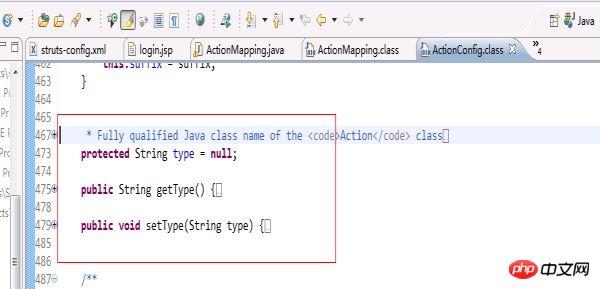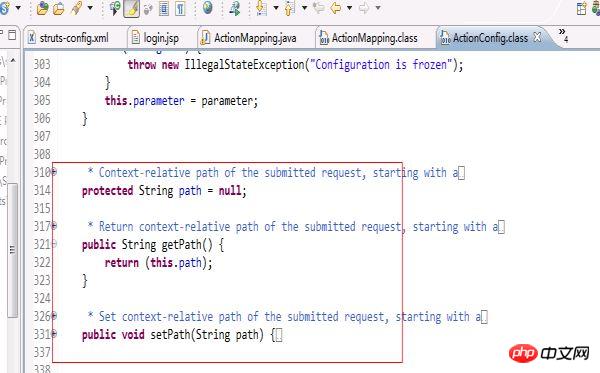关于Struts1之ActionMapping的示例详解
这篇文章主要介绍了Struts1教程之ActionMapping,小编觉得挺不错的,现在分享给大家,也给大家做个参考。一起跟随小编过来看看吧
首先断点走出了processpath方法,

这个方法是用来截取字符串的,今天我们来看怎样获得ActionMapping的方法---processMapping。
在此之前简单说一下ActionMapping,它的源代码中可以看出,其中最重要的属性和我们的mvc小实例中的ActionMapping类似,都是有path、type还有forwardMap,主要是对应的struts-config配置文件而来,这个就是保存这个配置文件的信息到内存中。
具体的mvc小实例的ActionMapping代码如下:
package com.cjq.servlet;
import java.util.Map;
public class ActionMapping {
private String path;
private Object type;
private Map forwardMap;
public String getPath() {
return path;
}
public void setPath(String path) {
this.path = path;
}
public Object getType() {
return type;
}
public void setType(Object type) {
this.type = type;
}
public Map getForwardMap() {
return forwardMap;
}
public void setForwardMap(Map forwardMap) {
this.forwardMap = forwardMap;
}
}而Struts中的Actionconfig(因为ActionMapping是继承这个ActionConfig的,所以我们来看ActionConfig更加直接)的代码如下:



从这两部分代码来看,更加印证了我在开篇写的mvc小实例是一个struts框架的雏形。
讲完ActionMapping的一些内容后,相信对ActionMapping有所了解,那么系统是如何生成ActionMapping和如何找到ActionMapping的呢?这就是今天要说的整体:
我们看下web.xml中有一个
进入断点调试,首先在processMapping方法上设置断点。

进入源代码中:
/**
* <p>Select the mapping used to process theselection path for this request
* If no mapping can be identified, createan error response and return
* <code>null</code>.</p>
*
* @param request The servlet request weare processing
* @param response The servlet response weare creating
* @param path The portion of the requestURI for selecting a mapping
*
* @exception IOException if an input/outputerror occurs
*/
protectedActionMapping processMapping(HttpServletRequestrequest,
HttpServletResponse response,
String path)
throws IOException {
// Is there a mapping for this path?
ActionMapping mapping = (ActionMapping)
moduleConfig.findActionConfig(path);
// If a mapping is found, put it in the request and return it
if (mapping != null) {
request.setAttribute(Globals.MAPPING_KEY, mapping);
return (mapping);
}
// Locate the mapping for unknown paths (if any)
ActionConfig configs[] = moduleConfig.findActionConfigs();
for (int i = 0; i < configs.length; i++) {
if (configs[i].getUnknown()) {
mapping = (ActionMapping)configs[i];
request.setAttribute(Globals.MAPPING_KEY, mapping);
return (mapping);
}
}
// No mapping can be found to process this request
String msg = getInternal().getMessage("processInvalid");
log.error(msg + " " + path);
response.sendError(HttpServletResponse.SC_NOT_FOUND, msg);
return null;
}首先我们传入我们在上一步截取的路径,通过moduleConfig的findAction方法来查找ActionConfig,并且返回ActionMapping。具体代码是:
ActionMapping mapping =(ActionMapping) moduleConfig.findActionConfig(path);
如果找到,那么就讲ActionMapping存放到request的context中。代码:
if (mapping != null) {
request.setAttribute(Globals.MAPPING_KEY, mapping);
return (mapping);
}如果没有通过path找到mapping,则在Actionconfig中遍历为未知路径寻找mapping,如果找到则存放到request中,如果没有找到,则返回错误信息,具体代码如下:
// Locate the mapping for unknownpaths (if any)
ActionConfig configs[] = moduleConfigfindActionConfigs();
for (int i = 0; i < configslength; i++) {
if (configs[i].getUnknown()) {
mapping = (ActionMapping)configs[i];
request.setAttribute(Globals.MAPPING_KEY, mapping);
return (mapping);
}
}
// No mapping can be found to process this request
String msg = getInternal().getMessage("processInvalid");
log.error(msg + " " + path);
response.sendError(HttpServletResponse.SC_NOT_FOUND, msg);
return null;来看下ActionServlet中的一个方法processActionForm,当我们在截取字符串,再根据字符串取得ActionMapping(这是前两篇文章中介绍的)之后,我们就要用利用ActionMapping来创建ActionForm了,并且把ActionForm放到request或session中管理。
先来看具体struts中processActionForm方法的具体实现:
/**
* <p>Retrieve and return the <code>ActionForm</code> associatedwith
* this mapping, creating and retaining oneif necessary. If there is no
* <code>ActionForm</code> associated with this mapping,return
* <code>null</code>.</p>
*
* @param request The servlet request weare processing
* @param response The servlet response weare creating
* @param mapping The mapping we are using
*/
protectedActionForm processActionForm(HttpServletRequestrequest,
HttpServletResponse response,
ActionMapping mapping) {
// Create (if necessary) a form bean to use
ActionForm instance = RequestUtilscreateActionForm
(request, mapping, moduleConfig, servlet);
if (instance == null) {
return (null);
}
// Store the new instance in the appropriate scope
if (log.isDebugEnabled()) {
log.debug(" Storing ActionForm bean instance in scope '" +
mapping.getScope() + "' under attribute key '" +
mapping.getAttribute() + "'");
}
if ("request".equals(mapping.getScope())) {
request.setAttribute(mapping.getAttribute(), instance);
} else {
HttpSession session =requestgetSession();
session.setAttribute(mapping.getAttribute(), instance);
}
return (instance);
}这个方法的大体流程是:根据ActionMapping中的name名称查找ActionForm,如果配置了ActionForm,那么就到request或session中查找,如果在request或session中存在已经创建的ActionForm,那么将返回。如果不存在那么会根据ActionForm的完成路径采用反射进行创建,再将创建好的ActionForm放到request或session中,之后返回ActionForm。
具体我们可以跟随断点调试来看看这个方法是如何运行的。
先设置断点,之后进入processActionForm方法。
第一个步骤就是创建ActionForm:
// Create (if necessary) a formbean to use
ActionForm instance = RequestUtils.createActionForm
(request, mapping, moduleConfig, servlet);
if (instance == null) {
return (null);
}通过调用RequestUtils.createActionForm的方法把ActionMapping中的ActionForm字符串生成对象,并且返回。进入这段代码中:
publicstaticActionForm createActionForm(
HttpServletRequest request,
ActionMapping mapping,
ModuleConfig moduleConfig,
ActionServlet servlet) {
// Is there a form bean associated with this mapping?
String attribute = mappinggetAttribute();
if (attribute == null) {
return (null);
}
// Look up the form bean configuration information to use
String name = mapping.getName();
FormBeanConfig config =moduleConfigfindFormBeanConfig(name);
if (config == null) {
log.warn("No FormBeanConfig found under '"+ name + "'");
return (null);
}
ActionForm instance = lookupActionForm(request,attribute, mappinggetScope());
// Can we recycle the existing form bean instance (if there is one)?
try {
if (instance != null && canReuseActionForm(instance,config)) {
return (instance);
}
} catch(ClassNotFoundException e) {
log.error(servlet.getInternal().getMessage("formBean",config.getType()), e);
return (null);
}
return createActionForm(config,servlet);
}方法首先定义变量name,并且从mapping中获取值,String name = mapping.getName();也就是我们实例中的LoginForm字符串。之后通过调用FormBeanConfig config =moduleConfig.findFormBeanConfig(name);这句话把相应的LoginForm字符串生成相应的对象。
这里要说明的是我们在struts-config配置文件中,配置过这样一个标签信息:
<form-beans>
<form-bean name="loginForm" type=".struts.LoginActionForm"/>
</form-beans>这个标签在服务器一启动的时候就会利用digester读取这里的配置信息,并且放在FormBeanConfig类中,这样我们可以通过上面那一句话就可以把LoginForm字符串生成相应的对象。
之后调用了ActionForm instance = lookupActionForm(request,attribute, mapping.getScope());这个方法,这个方法主要是查找scope属性中有没有存在ActionForm。具体实现:
if ("request".equals(scope)){
instance = (ActionForm)request.getAttribute(attribute);
} else {
session = request.getSession();
instance = (ActionForm)session.getAttribute(attribute);
}这里判断scope属性值是否为request,如果是则从request中读出ActionForm,如果不是则从session中读出。程序如果是第一次执行,那么ActionForm会是为空的。因为这里的ActionForm为空,所以就进入了if判断语句中,最后通过调用return createActionForm(config, servlet);创建ActionForm并且返回。
之后processActionForm就会把返回来的ActionForm放入request或者session中。具体实现就是:
if ("request".equals(mapping.getScope())){
request.setAttribute(mapping.getAttribute(), instance);
} else {
HttpSession session =request.getSession();
session.setAttribute(mapping.getAttribute(), instance);
}到此为止,ActionForm就创建完成,当ActionForm创建完成之后,就要用其他的方法来往ActionForm中赋值了
Atas ialah kandungan terperinci 关于Struts1之ActionMapping的示例详解. Untuk maklumat lanjut, sila ikut artikel berkaitan lain di laman web China PHP!

Alat AI Hot

Undresser.AI Undress
Apl berkuasa AI untuk mencipta foto bogel yang realistik

AI Clothes Remover
Alat AI dalam talian untuk mengeluarkan pakaian daripada foto.

Undress AI Tool
Gambar buka pakaian secara percuma

Clothoff.io
Penyingkiran pakaian AI

Video Face Swap
Tukar muka dalam mana-mana video dengan mudah menggunakan alat tukar muka AI percuma kami!

Artikel Panas

Alat panas

Notepad++7.3.1
Editor kod yang mudah digunakan dan percuma

SublimeText3 versi Cina
Versi Cina, sangat mudah digunakan

Hantar Studio 13.0.1
Persekitaran pembangunan bersepadu PHP yang berkuasa

Dreamweaver CS6
Alat pembangunan web visual

SublimeText3 versi Mac
Perisian penyuntingan kod peringkat Tuhan (SublimeText3)

Topik panas
 1677
1677
 14
14
 1431
1431
 52
52
 1334
1334
 25
25
 1280
1280
 29
29
 1257
1257
 24
24
 Penjelasan terperinci tentang fungsi mod dalam C++
Nov 18, 2023 pm 03:08 PM
Penjelasan terperinci tentang fungsi mod dalam C++
Nov 18, 2023 pm 03:08 PM
Penjelasan terperinci tentang fungsi mod dalam C++ Dalam statistik, mod merujuk kepada nilai yang paling kerap muncul dalam set data. Dalam bahasa C++, kita boleh mencari mod dalam mana-mana set data dengan menulis fungsi mod. Fungsi mod boleh dilaksanakan dalam pelbagai cara, dua daripada kaedah yang biasa digunakan akan diperkenalkan secara terperinci di bawah. Kaedah pertama ialah menggunakan jadual cincang untuk mengira bilangan kejadian setiap nombor. Pertama, kita perlu menentukan jadual cincang dengan setiap nombor sebagai kunci dan bilangan kejadian sebagai nilai. Kemudian, untuk set data yang diberikan, kami jalankan
 Penjelasan terperinci tentang mendapatkan hak pentadbir dalam Win11
Mar 08, 2024 pm 03:06 PM
Penjelasan terperinci tentang mendapatkan hak pentadbir dalam Win11
Mar 08, 2024 pm 03:06 PM
Sistem pengendalian Windows ialah salah satu sistem pengendalian yang paling popular di dunia, dan versi baharunya Win11 telah menarik perhatian ramai. Dalam sistem Win11, mendapatkan hak pentadbir adalah operasi penting Hak pentadbir membolehkan pengguna melakukan lebih banyak operasi dan tetapan pada sistem. Artikel ini akan memperkenalkan secara terperinci cara mendapatkan kebenaran pentadbir dalam sistem Win11 dan cara mengurus kebenaran dengan berkesan. Dalam sistem Win11, hak pentadbir dibahagikan kepada dua jenis: pentadbir tempatan dan pentadbir domain. Pentadbir tempatan mempunyai hak pentadbiran penuh ke atas komputer tempatan
 Penjelasan terperinci tentang operasi bahagian dalam Oracle SQL
Mar 10, 2024 am 09:51 AM
Penjelasan terperinci tentang operasi bahagian dalam Oracle SQL
Mar 10, 2024 am 09:51 AM
Penjelasan terperinci tentang operasi bahagi dalam OracleSQL Dalam OracleSQL, operasi bahagi ialah operasi matematik yang biasa dan penting, digunakan untuk mengira hasil pembahagian dua nombor. Bahagian sering digunakan dalam pertanyaan pangkalan data, jadi memahami operasi bahagian dan penggunaannya dalam OracleSQL adalah salah satu kemahiran penting untuk pembangun pangkalan data. Artikel ini akan membincangkan pengetahuan berkaitan operasi bahagian dalam OracleSQL secara terperinci dan menyediakan contoh kod khusus untuk rujukan pembaca. 1. Operasi bahagian dalam OracleSQL
 Penjelasan terperinci tentang penggunaan fungsi Vue.nextTick dan aplikasinya dalam kemas kini tak segerak
Jul 26, 2023 am 08:57 AM
Penjelasan terperinci tentang penggunaan fungsi Vue.nextTick dan aplikasinya dalam kemas kini tak segerak
Jul 26, 2023 am 08:57 AM
Penjelasan terperinci tentang penggunaan fungsi Vue.nextTick dan aplikasinya dalam kemas kini tak segerak Dalam pembangunan Vue, kami sering menghadapi situasi di mana data perlu dikemas kini secara tak segerak dilakukan serta-merta selepas data dikemas kini. Fungsi .nextTick yang disediakan oleh Vue muncul untuk menyelesaikan masalah jenis ini. Artikel ini akan memperkenalkan penggunaan fungsi Vue.nextTick secara terperinci, dan menggabungkannya dengan contoh kod untuk menggambarkan penggunaannya dalam kemas kini tak segerak. 1. Vue.nex
 Penjelasan terperinci tentang fungsi baki dalam C++
Nov 18, 2023 pm 02:41 PM
Penjelasan terperinci tentang fungsi baki dalam C++
Nov 18, 2023 pm 02:41 PM
Penjelasan terperinci tentang fungsi baki dalam C++ Dalam C++, operator baki (%) digunakan untuk mengira baki pembahagian dua nombor. Ia ialah pengendali binari yang operannya boleh terdiri daripada sebarang jenis integer (termasuk char, short, int, long, dll.) atau jenis nombor titik terapung (seperti float, double). Operator selebihnya mengembalikan hasil dengan tanda yang sama seperti dividen. Sebagai contoh, untuk baki operasi integer, kita boleh menggunakan kod berikut untuk melaksanakan: inta=10;intb=3;
 Penjelasan terperinci kaedah penalaan php-fpm
Jul 08, 2023 pm 04:31 PM
Penjelasan terperinci kaedah penalaan php-fpm
Jul 08, 2023 pm 04:31 PM
PHP-FPM ialah pengurus proses PHP yang biasa digunakan untuk menyediakan prestasi dan kestabilan PHP yang lebih baik. Walau bagaimanapun, dalam persekitaran beban tinggi, konfigurasi lalai PHP-FPM mungkin tidak memenuhi keperluan, jadi kami perlu menalanya. Artikel ini akan memperkenalkan kaedah penalaan PHP-FPM secara terperinci dan memberikan beberapa contoh kod. 1. Tingkatkan bilangan proses Secara lalai, PHP-FPM hanya memulakan sebilangan kecil proses untuk mengendalikan permintaan. Dalam persekitaran beban tinggi, kami boleh menambah baik keselarasan PHP-FPM dengan menambah bilangan proses
 Penjelasan terperinci tentang peranan dan penggunaan pengendali modulo PHP
Mar 19, 2024 pm 04:33 PM
Penjelasan terperinci tentang peranan dan penggunaan pengendali modulo PHP
Mar 19, 2024 pm 04:33 PM
Operator modulo (%) dalam PHP digunakan untuk mendapatkan baki pembahagian dua nombor. Dalam artikel ini, kami akan membincangkan peranan dan penggunaan pengendali modulo secara terperinci, dan memberikan contoh kod khusus untuk membantu pembaca memahami dengan lebih baik. 1. Peranan pengendali modulo Dalam matematik, apabila kita membahagi integer dengan integer lain, kita mendapat hasil bagi dan baki. Sebagai contoh, apabila kita membahagi 10 dengan 3, hasil bahagi ialah 3 dan selebihnya ialah 1. Operator modulo digunakan untuk mendapatkan baki ini. 2. Penggunaan operator modulo Dalam PHP, gunakan simbol % untuk mewakili modulus
 Penjelasan terperinci tentang fungsi sistem panggilan sistem linux().
Feb 22, 2024 pm 08:21 PM
Penjelasan terperinci tentang fungsi sistem panggilan sistem linux().
Feb 22, 2024 pm 08:21 PM
Penjelasan terperinci tentang fungsi sistem panggilan sistem Linux() Panggilan sistem ialah bahagian yang sangat penting dalam sistem pengendalian Linux Ia menyediakan cara untuk berinteraksi dengan kernel sistem. Antaranya, fungsi system() adalah salah satu fungsi panggilan sistem yang biasa digunakan. Artikel ini akan memperkenalkan penggunaan fungsi system() secara terperinci dan memberikan contoh kod yang sepadan. Konsep Asas Panggilan Sistem Panggilan sistem ialah satu cara untuk atur cara pengguna berinteraksi dengan kernel sistem pengendalian. Program pengguna meminta sistem pengendalian dengan memanggil fungsi panggilan sistem




